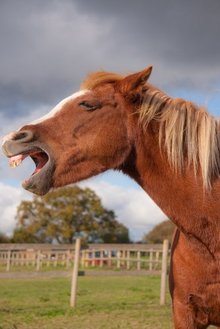Equines "talk" with each other all the time. Using a language unique to their species, they constantly use facial, vocal and body signals to communicate with each other, and, because these signals are the only language they know, they use the same language to communicate with humans.

A horse communicating through his neigh
According to a new study conducted by researchers in Switzerland, a horse's whinny reflects its emotions much like our voices can betray how we're feeling.
According to a new study conducted by researchers in Switzerland, a horse's whinny reflects its emotions -- much like our voices can betray how we're feeling -- in a very unusual way.
The study adds to a small but growing body of research on horse vocalizations. Previous research has shown that whinnies carry information about a horse's sex, body size, and identity, and that horses produce different kinds of sounds when they're excited than when they're distressed.
The new research looked at different parameters within the vocalizations with the aim of figuring out just how emotion gets encoded into the sound.
Together and alone. For the study, researchers studied 20 horses as they got separated from other horses and then reunited. The researchers recorded the horses' vocalizations and behavior, and measured their heart and breathing rates.
What did the scientists find? The horses produced long whinnies when they were separated, and short whinnies when they were reunited. The scientists used the animals' heart and breathing rate data to gauge their level of arousal and, by extension, their emotional state.
To their surprise, the scientists found that each whinny actually contained two distinct frequencies -- each conveying a different kind of emotional information.
âOne frequency [in the whinny] indicates whether the emotion is positive or negative, while the other frequency reveals the strength of the emotion,â Dr. Elodie Briefer, a postdoctoral research fellow at the Swiss Federal Institute of Technology in Zurich and the study's lead researcher, said in a written statement. "Such vocalizations with two fundamental frequencies are rare among mammals, in contrast, for example, to songbirds."
Better care. The researchers hope their findings will help horse owners and veterinarians better interpret the animals' emotions, and improve animal welfare. They plan to study whether whinnies of wild horses differ from those of domesticated horses, as well as from the vocalizations of other wild and domesticated animals.
Previous research has suggested that cows also have complex calls that indicate whether they are calm or distressed. The study was published online on April 21, 2015 in the journal Scientific Reports.
Other research has shown that horses have a wide range of vocal signals which they have used to their advantage down through history. Following are some of the important vocal signals horses use:
- Neigh: contact or recognition
- Nickers: depends on relationship: a stallion's courtship nicker; maternal nicker of mare to foal; friendship nicker to human with food
- Squeal: very close contact, especially sexual
- Snort: alarm, challenge excitement
- Screams and roars: extreme emotional state, rage, fear. If a horse screams or roars at you, get out of the way. It really means to hurt you. (Very rare)
- Grunts: effort, fighting, jumping; in cases of pain or colic, not an intentional signal
- High blowing noise made in false nostril: sign of pleasure especially when cantering
- Nose blowing or clearing: relaxed, happy with environment or work
